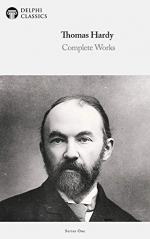|
This section contains 1,018 words (approx. 3 pages at 400 words per page) |

|
Summary
“Drummer Hodge” opens with the titular soldier’s burial, presumably after a battle in the Boer War. His grave, the opening lines reveal, are largely unmarked by anything manmade: he is “[thrown] in … to rest / Uncoffined—just as found” after the bloodshed (1-2). Instead, the “landmark” of Hodge’s grave is naturally occurring (3). The naturally occurring grave markers include “a kopje-crest” and “foreign constellations” (3, 5).
In Stanza II, the speaker attempts to further personalize Hodge from the anonymity of a burial unmarked by anything manmade. He includes biographical details, such that Hodge originates from a “Wessex home” (8). This “Wessex home” the speaker contrasts with the South African setting of the Boer War, “the broad Karoo, / The Bush, the dusty loam” (8-9). This contrast highlights “Fresh” Hodge’s innocence, represented by his parochial hometown in contrast with vastness and comparable foreignness of the Boer War’s...
(read more from the Lines 1 – 18 Summary)
|
This section contains 1,018 words (approx. 3 pages at 400 words per page) |

|




